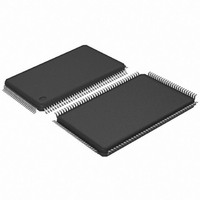AT91SAM7L64-AU Atmel, AT91SAM7L64-AU Datasheet - Page 383

AT91SAM7L64-AU
Manufacturer Part Number
AT91SAM7L64-AU
Description
MCU ARM7 64K HS FLASH 128-LQFP
Manufacturer
Atmel
Series
AT91SAMr
Specifications of AT91SAM7L64-AU
Core Processor
ARM7
Core Size
16/32-Bit
Speed
36MHz
Connectivity
I²C, SPI, UART/USART
Peripherals
Brown-out Detect/Reset, LCD, POR, PWM, WDT
Number Of I /o
80
Program Memory Size
64KB (64K x 8)
Program Memory Type
FLASH
Ram Size
6K x 8
Voltage - Supply (vcc/vdd)
1.55 V ~ 1.8 V
Data Converters
A/D 4x10b
Oscillator Type
Internal
Operating Temperature
-40°C ~ 85°C
Package / Case
128-LQFP
Controller Family/series
AT91SAM7xxx
No. Of I/o's
80
Ram Memory Size
6KB
Cpu Speed
36MHz
No. Of Timers
1
Rohs Compliant
Yes
Processor Series
AT91SAMx
Core
ARM7TDMI
Data Bus Width
32 bit
Data Ram Size
6 KB
Interface Type
2-Wire, SPI, USART
Maximum Clock Frequency
36 MHz
Number Of Programmable I/os
80
Number Of Timers
3
Maximum Operating Temperature
+ 85 C
Mounting Style
SMD/SMT
3rd Party Development Tools
JTRACE-ARM-2M, MDK-ARM, RL-ARM, ULINK2
Development Tools By Supplier
AT91SAM-ICE, AT91-ISP, AT91SAM7L-EK
Minimum Operating Temperature
- 40 C
On-chip Adc
10 bit, 4 Channel
For Use With
AT91SAM7L-STK - KIT EVAL FOR AT91SAM7LAT91SAM-ICE - EMULATOR FOR AT91 ARM7/ARM9
Lead Free Status / RoHS Status
Lead free / RoHS Compliant
Eeprom Size
-
Lead Free Status / Rohs Status
Details
Available stocks
Company
Part Number
Manufacturer
Quantity
Price
- Current page: 383 of 564
- Download datasheet (9Mb)
Figure 30-23. Timeguard Operations
30.6.3.12
6257A–ATARM–20-Feb-08
Baud Rate
TXEMPTY
US_THR
TXRDY
Clock
Write
TXD
Receiver Time-out
Start
Bit
D0
D1
Table 30-7
in relation to the function of the Baud Rate.
Table 30-7.
The Receiver Time-out provides support in handling variable-length frames. This feature detects
an idle condition on the RXD line. When a time-out is detected, the bit TIMEOUT in the Channel
Status Register (US_CSR) rises and can generate an interrupt, thus indicating to the driver an
end of frame.
The time-out delay period (during which the receiver waits for a new character) is programmed
in the TO field of the Receiver Time-out Register (US_RTOR). If the TO field is programmed at
0, the Receiver Time-out is disabled and no time-out is detected. The TIMEOUT bit in US_CSR
remains at 0. Otherwise, the receiver loads a 16-bit counter with the value programmed in TO.
This counter is decremented at each bit period and reloaded each time a new character is
received. If the counter reaches 0, the TIMEOUT bit in the Status Register rises. Then, the user
can either:
D2
• Stop the counter clock until a new character is received. This is performed by writing the
Control Register (US_CR) with the STTTO (Start Time-out) bit at 1. In this case, the idle state
D3
D4
D5
Baud Rate
indicates the maximum length of a timeguard period that the transmitter can handle
115200
Bit/sec
14400
19200
28800
33400
56000
57600
1 200
9 600
D6
Maximum Timeguard Length Depending on Baud Rate
D7
Parity
Bit
Stop
Bit
TG = 4
AT91SAM7L128/64 Preliminary
Start
Bit
D0
Bit time
69.4
52.1
34.7
29.9
17.9
17.4
833
104
D1
8.7
µs
D2
D3
D4
D5
D6
D7
Parity
Bit
Stop
Bit
Timeguard
212.50
17.71
13.28
26.56
8.85
7.63
4.55
4.43
2.21
ms
TG = 4
383
Related parts for AT91SAM7L64-AU
Image
Part Number
Description
Manufacturer
Datasheet
Request
R

Part Number:
Description:
KIT EVAL FOR AT91SAM7L
Manufacturer:
Atmel
Datasheet:

Part Number:
Description:
DEV KIT FOR AVR/AVR32
Manufacturer:
Atmel
Datasheet:

Part Number:
Description:
INTERVAL AND WIPE/WASH WIPER CONTROL IC WITH DELAY
Manufacturer:
ATMEL Corporation
Datasheet:

Part Number:
Description:
Low-Voltage Voice-Switched IC for Hands-Free Operation
Manufacturer:
ATMEL Corporation
Datasheet:

Part Number:
Description:
MONOLITHIC INTEGRATED FEATUREPHONE CIRCUIT
Manufacturer:
ATMEL Corporation
Datasheet:

Part Number:
Description:
AM-FM Receiver IC U4255BM-M
Manufacturer:
ATMEL Corporation
Datasheet:

Part Number:
Description:
Monolithic Integrated Feature Phone Circuit
Manufacturer:
ATMEL Corporation
Datasheet:

Part Number:
Description:
Multistandard Video-IF and Quasi Parallel Sound Processing
Manufacturer:
ATMEL Corporation
Datasheet:

Part Number:
Description:
High-performance EE PLD
Manufacturer:
ATMEL Corporation
Datasheet:

Part Number:
Description:
8-bit Flash Microcontroller
Manufacturer:
ATMEL Corporation
Datasheet:

Part Number:
Description:
2-Wire Serial EEPROM
Manufacturer:
ATMEL Corporation
Datasheet:











